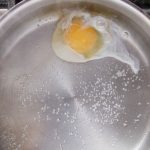 To cook in water just below the boiling point of the water.
To cook in water just below the boiling point of the water.
Although poached eggs and chickenpox are not connected causally, they are related etymologically: they both derive part of their name from a Germanic word, pronounced something like puk, that meant to swell. This Germanic source developed quite straightforwardly into pox, an old name for the small pustules that swell and erupt on the skin of someone who is afflicted with chickenpox, smallpox, cowpox, or even what the English used to call the French pox. The evolution of puk into the culinary term poach is more circuitous. First it developed into the Prankish word pokka, meaning bag, a small sack that “swells” in size when filled with grain, or potatoes, or cats. Pokka then was adopted by French as poche, meaning pocket, which gave rise to the French verb pocher, meaning to put in a pocket. The French then came up with the idea of using pocher as a culinary term because if you simmer eggs in stock, a pocket of white forms around the yolk; the English borrowed this French culinary term in the early fifteenth century, respelling it as poach. Other words that derive from the French poche include pouch, pocket, and poke. This last word now exists only in the phrase to buy a pig in a poke, meaning to buy something without first examining it. The expression arose out of the old trick—perhaps more often remembered than performed—of selling someone a suckling pig safely tied up in a bag; upon returning home, the hoodwinked customer would discover that his poke contained not a tasty pig but a groggy cat, one soon let out of the bag.
A method of cooking using water heated to a temperature just below boiling.
To cook using the method of immersion in liquid is a popular cooking technique that involves completely or partially submerging food in water or another type of liquid that may be heated to or below the boiling point. This method of cooking is often used for delicate or fragile foods, such as fish or eggs, as it allows for gentle and even cooking that helps to preserve the food’s texture and flavor. Alternatively, this method can also be used for tougher cuts of meat that require extended cooking times, resulting in a tender and flavorful end product. Another variation of this method involves cooking in a bain-marie, which involves the use of a double boiler or water bath to provide gentle and indirect heat for delicate dishes such as custards or sauces.
